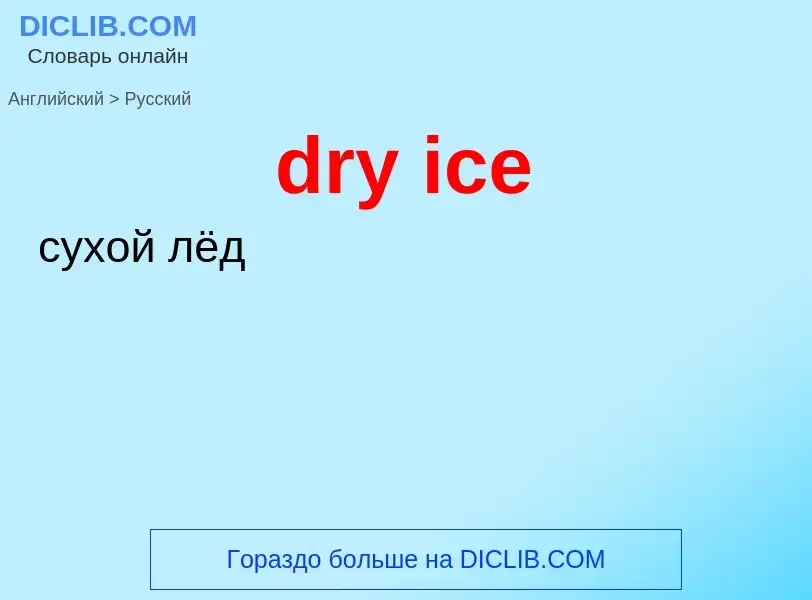Перевод и анализ слов искусственным интеллектом ChatGPT
На этой странице Вы можете получить подробный анализ слова или словосочетания, произведенный с помощью лучшей на сегодняшний день технологии искусственного интеллекта:
- как употребляется слово
- частота употребления
- используется оно чаще в устной или письменной речи
- варианты перевода слова
- примеры употребления (несколько фраз с переводом)
- этимология
dry ice - перевод на русский
медицина
сухой лёд
твёрдая углекислота
строительное дело
припай, неподвижный лёд
строительное дело
автозимник
география
лед глетчерный
лед монолитный
общая лексика
образование льда
обледенение
строительное дело
льдообразование (в грунтах)
Определение
Википедия

Dry ice is the solid form of carbon dioxide. It is commonly used for temporary refrigeration as CO2 does not have a liquid state at normal atmospheric pressure and sublimates directly from the solid state to the gas state. It is used primarily as a cooling agent, but is also used in fog machines at theatres for dramatic effects. Its advantages include lower temperature than that of water ice and not leaving any residue (other than incidental frost from moisture in the atmosphere). It is useful for preserving frozen foods (such as ice cream) where mechanical cooling is unavailable.
Dry ice sublimates at 194.7 K (−78.5 °C; −109.2 °F) at Earth atmospheric pressure. This extreme cold makes the solid dangerous to handle without protection from frostbite injury. While generally not very toxic, the outgassing from it can cause hypercapnia (abnormally elevated carbon dioxide levels in the blood) due to buildup in confined locations.






![Dry ice blasting used for cleaning a [[rubber]] mold Dry ice blasting used for cleaning a [[rubber]] mold](https://commons.wikimedia.org/wiki/Special:FilePath/Rubbermold.jpg?width=200)


.jpg?width=200)


![SnowCastle]] [[ice hotel]] in [[Finland]] SnowCastle]] [[ice hotel]] in [[Finland]]](https://commons.wikimedia.org/wiki/Special:FilePath/Castello di neve in lapponia 02 (2108559776).jpg?width=200)
![Feather ice on the plateau near [[Alta, Norway]]. The crystals form at temperatures below −30 °C (−22 °F). Feather ice on the plateau near [[Alta, Norway]]. The crystals form at temperatures below −30 °C (−22 °F).](https://commons.wikimedia.org/wiki/Special:FilePath/Feather ice 1, Alta plateau, Norway.jpg?width=200)
![Channel through ice for ship traffic on [[Lake Huron]] with [[ice breaker]]s in background Channel through ice for ship traffic on [[Lake Huron]] with [[ice breaker]]s in background](https://commons.wikimedia.org/wiki/Special:FilePath/Frozen Lake Huron- icebreakers and commercial vessels.jpg?width=200)

![Harvesting ice on [[Lake St. Clair]] in [[Michigan]], c. 1905 Harvesting ice on [[Lake St. Clair]] in [[Michigan]], c. 1905](https://commons.wikimedia.org/wiki/Special:FilePath/Ice Harvesting on Lake St Clair Michigan circa 1905--photograph courtesy Detroit Publishing Company.jpg?width=200)

![Ice on deciduous tree after [[freezing rain]] Ice on deciduous tree after [[freezing rain]]](https://commons.wikimedia.org/wiki/Special:FilePath/Icy Japanese Maple branch, Boxborough, Massachusetts, 2008.jpg?width=200)

![''Skating fun'' by 17th century Dutch painter [[Hendrick Avercamp]] ''Skating fun'' by 17th century Dutch painter [[Hendrick Avercamp]]](https://commons.wikimedia.org/wiki/Special:FilePath/SCENEONICE.jpg?width=200)
![Loss of control on ice by an [[articulated bus]] Loss of control on ice by an [[articulated bus]]](https://commons.wikimedia.org/wiki/Special:FilePath/Scania articulated bus on icy road.jpg?width=200)

![[[Snowflake]]s by [[Wilson Bentley]], 1902. [[Snowflake]]s by [[Wilson Bentley]], 1902.](https://commons.wikimedia.org/wiki/Special:FilePath/SnowflakesWilsonBentley.jpg?width=200)
![black pneumatic boot]]. black pneumatic boot]].](https://commons.wikimedia.org/wiki/Special:FilePath/Some Ice on the boots (1527659244).jpg?width=200)
![Ice pier during 1983 cargo operations. [[McMurdo Station]], Antarctica Ice pier during 1983 cargo operations. [[McMurdo Station]], Antarctica](https://commons.wikimedia.org/wiki/Special:FilePath/USNS Southern Cross at the ice pier in 1983.jpg?width=200)
